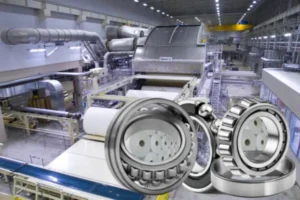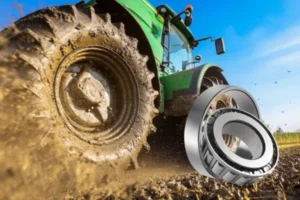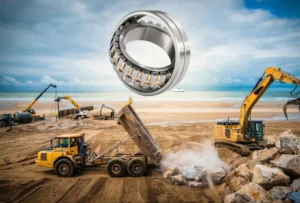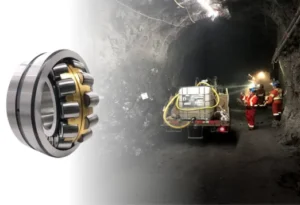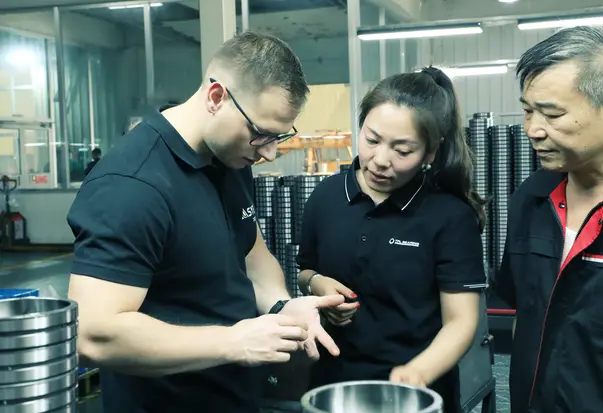Needle thrust bearings work very well in precision machines. They can hold heavy loads in small spaces. Their special design helps in aerospace, robotics, medical devices, and cars. The global market for these bearings was $1.2 billion in 2024. It may grow to $1.9 billion by 2033. This growth is because people want better accuracy and less wear.
Engineers use needle thrust bearings for better reliability and new ideas.

Key Takeaways
- Needle thrust bearings are small and strong. They fit in tight spaces. They can hold heavy loads.
- Their long, thin rollers lower friction. They spread force evenly. This helps machines work smoothly. It also helps them last longer.
- These bearings help machines be more precise and stable. They are used in robots, planes, medical tools, and cars.
- Choosing the right bearing is important. Installing them the right way matters too. Regular care keeps needle thrust bearings working well.
- Using needle thrust bearings makes machines quieter. It also makes them lighter and stronger. They work well even in tough places.
Design and Function
Needle Roller Structure
Needle thrust bearings have thin, long rollers called needle rollers. These rollers are much longer than they are wide. The shape lets the bearing fit into small spaces. The rollers are three to ten times longer than their width. This design helps the bearing hold heavy loads, even though it is small. Engineers use cages to keep the rollers in place. The small size makes these bearings good for tight spots. They can touch moving parts and handle strong pushes and shocks. But, they do not work for radial loads. This makes them different from other bearings.
- Liked for small size
- Can touch moving parts
- Handles strong pushes and shocks
- Not for radial loads
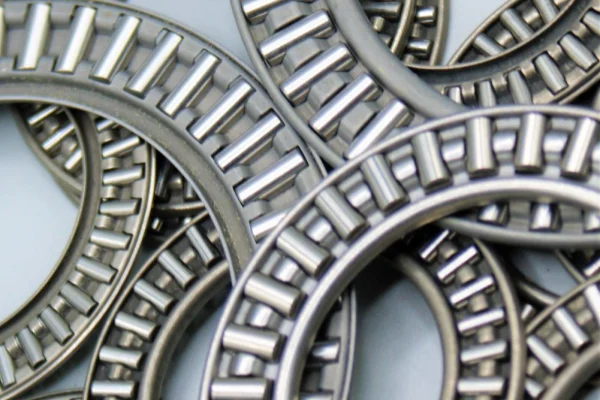
Load Distribution
The shape of needle thrust bearings spreads out the force. The long, thin rollers help share the load over more space. This means the bearing can hold both radial and axial loads in some types, but most focus on axial loads. The big contact area helps hold heavy loads in a small size. Good materials and careful building make them last longer and work better. These bearings are used in car transmissions, compressors, and gearboxes. They must hold strong pushes in small places. Their strength makes them a top pick for many uses.
Friction Reduction
Needle thrust bearings lower friction by rolling, not sliding. The rollers move between hard raceways, which cuts down on sliding and wear. This makes the bearing work better and last longer. The table below shows main features and benefits:
| Feature/Benefit | Explanation |
|---|---|
| Friction Reduction Mechanism | Rollers move between hard raceways, so there is less sliding and wear. |
| Contact Surface Area | Big area helps hold heavy loads in a small size. |
| Load Capacity | Can hold 2 to 8 times more weight than other bearings. |
| Service Life | Better cage designs make them last up to five times longer. |
| Additional Benefits | Less wear, better work, quiet use, and strong build. |
New materials like strong steels and ceramic coatings help cut friction and make them last longer. These changes help thrust bearings work well in tough jobs. This makes them very important in today’s precision machines.
Advantages of Needle Thrust Bearings
Compact Size
Needle thrust bearings are very thin and fit in small spaces. Engineers make them with long, thin rollers. These rollers touch more area but keep the bearing small. Because they are compact, machines can be lighter and work better. Many companies use these bearings when there is not much room. They are found in car transmissions, pumps, and gearboxes.
- The thin shape helps make machines smaller.
- Slim bearings hold strong pushes but do not need much space.
- Makers can put these bearings right on machine parts to save space.
- Thin rings and thrust washers help keep the bearing small.
- Even though they are small, these bearings can go fast and last long.
This mix of good work and small size makes needle thrust bearings important for machines that need to be exact.

High Load Capacity
Needle thrust bearings can hold a lot of weight. Their special rollers spread out the force over a big area. This lets them handle strong pushes. This is very important in gearboxes and compressors.
Note: Because they are small and strong, engineers can make lighter machines that are still tough and safe.
The price matters when picking bearings. Better materials and careful building can make them cost more. But being able to hold heavy loads in small spaces is worth it. This is true for machines that need to work very well.
Precision and Stability
Needle thrust bearings are made to be very exact. Makers use special rollers and cages to lower friction and help things move smoothly. These bearings keep tight spaces between parts. This helps machines move the same way every time.
| Innovation Aspect | Description | Sector/Application |
|---|---|---|
| High load capacity & compact design | Good for strong pushes in small spaces, helping machines be neat. | Automotive, Industrial Machinery |
| Advanced materials | Special plastics and ceramics make them last longer and handle heat. | Automation, Electric Vehicles |
| Digital transformation | Smart bearings with sensors help fix problems before they get worse. | Robotics, Industrial Automation |
Needle thrust bearings help new ideas in many fields. Planes, wind power, and robots all use them because they are steady and strong. Makers can change these bearings to fit special jobs. This keeps machines working well and helps new technology grow. Using better materials and smart features makes them even more useful in today’s machines.
Applications in Precision Machinery
Aerospace Systems
Aerospace engineers use needle thrust bearings in important aircraft parts. These bearings fit where there is not much space. They help move parts in flight control systems and satellites. The small size makes planes lighter and saves fuel. Lighter planes can carry more things. These bearings stay steady and accurate, even when it is very hot or cold. They can handle strong pushes during takeoff, flight, and landing. This makes them a good choice for many jobs in aerospace.
Robotics and Automation
Robots and machines need to be exact and work well. Needle thrust bearings are used in robot arms and joints. Their thin shape saves space, so robots can be smaller. These bearings hold heavy things but keep friction low. Less friction means less heat and wear. Special rollers help the bearings move smoothly. Strong materials make them last longer, even with lots of use. The TFL needle roller bearing is 30% stiffer and has 20% less friction than old types. This helps robots work better and break down less. It also makes robots more productive. These bearings are easy to put in and take care of, so machines keep working.
- Small design fits in robot arms and joints.
- Can hold heavy tools and loads.
- Low friction helps them last longer and saves energy.
- Even load sharing makes movement smooth and exact.
Medical and Optical Equipment
Medical and optical tools need to move just right and be reliable. Needle thrust bearings are small but can hold a lot of weight. Many surgery tools use these bearings for smooth, careful moves. This helps doctors do better work. Imaging machines like MRI and X-ray use them for exact moves and turning. Lab tools use them for tiny changes, which are important for science. In microscopes and telescopes, the bearings help with careful moves and clear focus. These uses get better accuracy, smoother work, and more trust. This means better care for patients and clearer views for scientists.
Automotive and Industrial Uses
Car transmissions and big machines use needle thrust bearings for strong pushes in small spaces. In cars, these bearings help gears, clutches, and differentials move. They make transmissions work better and last longer. Big machines like pumps and compressors also use these bearings for steady work. The small size lets them fit in tight spots but still hold heavy loads. These bearings have low friction, are easy to care for, and last a long time. With good oil, they can last over 12 years in cars. In pumps and compressors, they help machines work well in tough places. This makes them very important for many big machines.
Tip: Picking the right bearing can make machines last longer, cost less to fix, and work better.
Performance in Demanding Environments
High-Speed Operation
Needle thrust bearings are used in machines that spin fast. The KT series is light and small, so it works well in engines and pumps. These bearings can move quickly but are made for axial loads. Deep groove ball bearings do better at very high speeds. Needle thrust bearings need oil to stop them from wearing out or getting too hot. If they do not have enough oil, they can break fast. Workers must check these bearings often to keep machines working well.
- KT series: Works well for fast, light jobs.
- AXK series: Gives strong support for axial loads.
- Deep groove ball bearings: Best for very fast spinning.
- Good oil: Needed for safe and long use.
Heavy Axial Loads
Thrust bearings are great when machines need to handle big pushes along the shaft. Their needle roller shape spreads the force over more space. This makes them good for small spots in cars and farm machines. Strong retainers hold the rollers and guide them. These bearings last longer and work better in tough places than ball thrust bearings. They are easy to put in and help move force smoothly.
- Can handle big pushes in tight spaces.
- Retainers help rollers move evenly.
- Used in cars, farms, and factories.
- Work better than ball thrust bearings for heavy loads.
Vibration and Noise Control
Precision machines need to be quiet and steady. Needle thrust bearings help lower shaking and noise. Their design cuts down friction and keeps things moving smoothly. In spindles and tools, these bearings stop shaking. This helps machines last longer and work better. Good materials and tight fits also help stop wear and keep parts close together. These things are very important in robots and medical tools, where every move matters.
Tip: Needle thrust bearings can make machines quieter, last longer, and easier to fix.
Selection and Maintenance
Choosing the Right Bearing
Engineers pick the right bearing by checking many things. They look at what kind of load the bearing will hold. For thrust bearings, they focus on axial loads. The shape and size must fit the machine’s space. Speed and oil needs are important for how well it works. The material matters for heat and wear. Internal clearances help stop shaking. The fit type keeps the bearing steady and straight. Precision machines need bearings made to exact sizes. Special materials and better oil help lower shaking and keep things moving right. Engineers also think about heat changes, spinning forces, and how hot it can get.
Key Selection Criteria:
- Load type and capacity
- Bearing geometry and size
- Operating speed and lubrication
- Material properties
- Internal clearance and fit
- Shock and axial load handling
- Tight tolerances for precision
Installation Tips
Putting in the bearing the right way helps it work well and last longer. Many mistakes can be stopped by following careful steps.
- Pick the right shaft fit so the bearing does not slip.
- Do not let the bearing get too hot when putting it in.
- Use the right locks to stop the bearing from moving.
- Line up the bearing so the load is even.
- Use safe and easy ways to put it in to avoid getting hurt.
Tip: Always use the maker’s rules for oil and handling. Keep the bearing clean and wear gloves so dirt does not get in.
Maintenance Best Practices
Taking care of the bearing often helps it last longer and work better. A good plan finds problems early and stops long breaks. Oil the bearing as told to stop it from breaking. Check and clean the bearing a lot to keep out dirt and water. Make sure the bearing stays straight when used. Watch the loads and do not let them get too heavy. Use tools to check for problems early. Change the bearing if you hear noise, feel shaking, or see it getting hot. Teach workers how to put in and clean bearings the right way.
| Maintenance Task | Benefit |
|---|---|
| Regular inspection | Finds problems early |
| Correct lubrication | Reduces wear and failure |
Clean handling | Prevents contamination |
Proper alignment | Stops uneven loading |
Condition monitoring | Improves reliability |
Needle thrust bearings help make precision machines better. They are small, strong, and very reliable. Experts talk about new ideas like special preloading, custom shapes, and seals. These things help robots, planes, and medical tools work better and last longer.
- Engineers get help from easy-to-read guides, online classes, and trusted suppliers.
- TFL Bearings gives smart advice and good products for any job.
For better performance and lasting use, engineers can count on TFL Bearings to give the right needle thrust bearing every time.
FAQ
What makes needle thrust bearings different from other thrust bearings?
Needle thrust bearings have long, thin rollers. These rollers help the bearing fit in small spaces. They can also hold more weight than ball thrust bearings of the same size.
How do engineers choose the right needle thrust bearing?
Engineers look at the type of load and how fast it spins. They also check how much space there is. The material and oil needs are important too. They pick the bearing that fits the machine best.
Can needle thrust bearings work in high-speed machines?
Yes, they can work in fast machines. Good oil and regular checks help them last longer. This keeps them working well in quick-moving machines.
What maintenance do needle thrust bearings need?
Checking the bearing often and using the right oil helps it work well. Keeping it clean and lined up right stops it from breaking early.
Where do industries use needle thrust bearings most?
| Industry | Common Application |
|---|---|
| Aerospace | Flight control systems |
| Robotics | Robot joints and arms |
| Automotive | Transmissions, gearboxes |
| Medical | Surgical and imaging tools |
